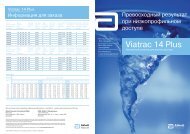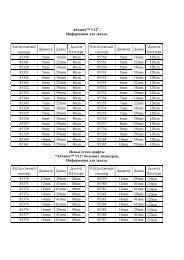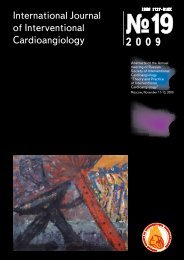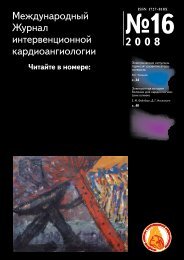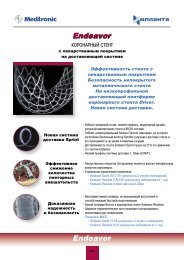Results of Coronary Stenting using the Stents with
Results of Coronary Stenting using the Stents with
Results of Coronary Stenting using the Stents with
Create successful ePaper yourself
Turn your PDF publications into a flip-book with our unique Google optimized e-Paper software.
Интервенционная Cardiovascular ангиология<br />
surgery<br />
Fig. 5. Second stage — left-sided carotid-subclavian bypass grafting,<br />
endovascular grafting <strong>of</strong> <strong>the</strong> aortic arch and <strong>the</strong> descending aorta<br />
Fig. 6. Postoperative MHCT <strong>of</strong> patient A<br />
Fig. 7. MHCT-aortography <strong>of</strong> patient Z. after <strong>the</strong> 2nd stage <strong>of</strong><br />
intervention<br />
arch replacement <strong>with</strong> an endograft<br />
were performed (Fig. 5).<br />
The first stage (October 4, 2010):<br />
<strong>the</strong> heart was approached through<br />
median sternotomy. A T-shaped<br />
aortotomy was performed above <strong>the</strong><br />
sinoaortic area. The revision showed<br />
<strong>the</strong> dissection starting from <strong>the</strong><br />
level <strong>of</strong> aortic valve’s commissures,<br />
spreads into <strong>the</strong> anterior, lateral and<br />
posterior aortic walls involving <strong>the</strong><br />
right coronary artery ostium, and<br />
<strong>the</strong>n spreads into <strong>the</strong> aortic arch in<br />
<strong>the</strong> shape <strong>of</strong> a two-barreled gun. The<br />
button-like isolation <strong>of</strong> <strong>the</strong> coronary<br />
ostia was performed for subsequent<br />
implantation. The valve’s cusps<br />
were sectioned. The aortic valve and<br />
<strong>the</strong> ascending aorta were replaced<br />
by a valved conduit Carbomedics<br />
Inc. (aortic valve pros<strong>the</strong>sis 25, graft<br />
diameter 28). The right and <strong>the</strong> left<br />
coronary arteries were reimplanted<br />
onto <strong>the</strong> conduit. The revision <strong>of</strong> <strong>the</strong><br />
aortic arch revealed that <strong>the</strong> dissection<br />
spreading in <strong>the</strong> upper wall <strong>of</strong><br />
<strong>the</strong> aorta, ends by a fenestration at<br />
<strong>the</strong> level <strong>of</strong> brachiocephalic trunk;<br />
<strong>the</strong> dissection involving <strong>the</strong> posterior<br />
and <strong>the</strong> lateral walls spreads into<br />
<strong>the</strong> arch and ends in <strong>the</strong> area <strong>of</strong> <strong>the</strong><br />
left subclavian artery ostium. The<br />
aortic arch branches arise from <strong>the</strong><br />
true lumen. The aortic arch was sectioned<br />
in oblique way, <strong>with</strong> <strong>the</strong> preservation<br />
<strong>of</strong> <strong>the</strong> upper wall and a part<br />
<strong>of</strong> lateral walls. The false lumen was<br />
eliminated and <strong>the</strong> distal anastomosis<br />
line was reinforced <strong>with</strong> internal<br />
and external padded sutures (<strong>the</strong><br />
“layered cake”). The distal anastomosis<br />
between <strong>the</strong> conduit and <strong>the</strong><br />
aorta was performed <strong>using</strong> <strong>the</strong> open<br />
technique.<br />
The second stage (October 7,<br />
2010): <strong>the</strong> procedure was performed<br />
under endotracheal anes<strong>the</strong>sis.<br />
The approach to <strong>the</strong> left<br />
common carotid artery and <strong>the</strong> left<br />
subclavian artery was achieved<br />
through <strong>the</strong> supraclavicular incision.<br />
An “end-to-side” anastomosis<br />
was performed between <strong>the</strong><br />
subclavian artery and <strong>the</strong> common<br />
carotid artery. Simultaneously an<br />
introducer was inserted into <strong>the</strong><br />
left common femoral artery; on <strong>the</strong><br />
right <strong>the</strong> introducer was inserted<br />
percutaneously. The diagnostic<br />
ca<strong>the</strong>ters were advanced by<br />
50<br />
(№ 26, 2011)




